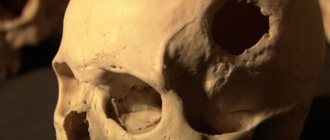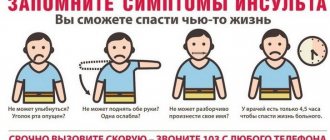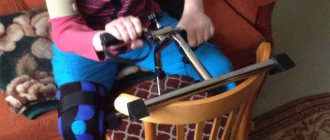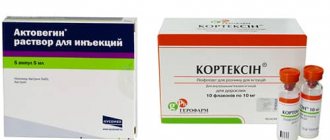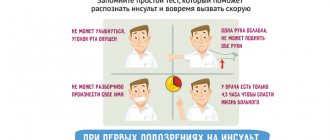Types of seizures after a stroke
Doctors distinguish 3 forms of post-stroke epilepsy:
- Harbingers . Usually begin several months or years before the onset of a stroke. They are mainly associated with the ischemic form of the disease, which is characterized by oxygen starvation and impaired blood circulation in certain areas of the brain for a long time. In some patients, a mini-stroke is predicted several days or weeks in advance.
- Early attacks . They develop within 6-7 days after the onset of an ischemic attack. Seizures are acute in nature and can appear either together with a stroke or immediately after it. If help is provided in time, the prognosis is favorable.
- Late attacks . They develop 7-8 days after a stroke. Occurs in 65-70% of patients, so you need to be prepared for a similar condition within the specified time after acute ischemia. The prognosis worsens if first aid is provided too late.
Epilepsy can be called only those seizures after a stroke that persist for some time.
Epilepsy and stroke: causes and types
July 08, 2019
Epilepsy and stroke are related: cerebrovascular accidents provoke seizures. This combination is observed in approximately 30% of elderly patients with epilepsy.
Epilepsy is a neurological disease that manifests itself in sudden attacks of seizures.
In some cases, the disease is also accompanied by migraines, anxiety, depression and other nervous system disorders.
Types of epileptic seizures
Epileptic seizures associated with stroke are of three types:
Precursors are recorded in approximately 15% of patients with strokes. Seizures are caused by deterioration of cerebral circulation and insufficient oxygen supply to areas of the brain.
Early attacks of epilepsy after stroke, which develop in the first week after acute cerebrovascular accident. With timely assistance, patients with such disorders have a good prognosis.
Late attacks of epilepsy after stroke are observed in patients 7 days after an acute stroke. Within a year, post-stroke epilepsy develops in approximately 60% of patients.
Why does epilepsy occur after a stroke?
Stroke patients, and especially their families and caregivers, should be aware that cerebrovascular accidents in many cases lead to epilepsy after stroke, and treatment should take this into account. There may be several reasons for this:
- Vascular insufficiency. As a rule, precursor attacks appear for this reason. The patient does not yet have any diagnosis, but the seizures indicate that a stroke is possible.
- Changes in tissues that cause increased excitability of neurons.
- Late attacks of epilepsy are usually the result of a serious restructuring of the nervous tissue, which all becomes more excitable than normal.
- An important risk factor for the development of epilepsy (including its earlier development) is the hemorrhagic type of stroke. It leads to seizures more often than ischemic stroke.
- If a stroke is associated with blockage of the central veins of the brain, then the development of epilepsy is more likely. Moreover, it can be the first sign of a stroke.
Scientists are also currently discussing whether the incidence of epilepsy is related to the age of the patient and the severity of the stroke itself, but controversial data have so far been obtained in this area. Although a connection with age seems more likely: the older the patient, the less potential the nerve tissue has for recovery. As a consequence, the formation of foci of hyperexcitability, which is not compensated for by anything.
Note:
Not everyone can recognize an epileptic attack, especially if they encounter it for the first time. Usually the attack is preceded by an aura - a condition that patients cannot definitely explain, but they feel that “something is wrong with them.” If the attack does not occur for the first time, then patients may feel the approach of seizures.
Then the person loses consciousness, he begins to have convulsions, his breathing pattern changes, his tongue may sink in and foam may appear at the mouth. There are seizures in the form of abansis - the person seems to freeze and switch off for a few seconds. There are no convulsions, but the body may “twitch”. The ban lasts approximately 30 seconds.
danger of epileptic seizures
Doctors note that if a patient develops epilepsy after a stroke, this increases the risk of recurrent cerebral hemorrhage. In addition, convulsions during an attack impair the functioning of internal organs, which can also have negative consequences.
The risk of injury directly during an attack also increases. Since a person usually loses consciousness, he may hit himself during a fall, including causing a concussion. Food in the mouth during an attack, removable dentures, tight clothing - everything poses a danger as it can block the airway.
What to do if you have an epileptic seizure
For people who find themselves near a patient during an epileptic seizure, there is an algorithm of actions:
- the patient must be laid down, freed from tight clothing, and air access must be provided
- remove from the mouth everything that was there at the time of the attack: food, dentures, etc.
- If the patient starts vomiting, he should be placed on his side and his mouth should be cleared of vomit.
- try to avoid additional injuries during an attack. In particular, you can put something soft under your head, but under no circumstances hold your arms and legs
- do not try to revive a person during an attack
Treatment options for epilepsy after a stroke can only be suggested by a doctor. It depends on the current condition of the patient, the volume and nature of brain damage after a stroke, and the nature of the seizures themselves.
It is extremely important for patients to follow the medication schedule recommended by the doctor, as well as to get rid of bad habits: smoking and drinking alcohol.
This increases the chances that treatment for epilepsy after a stroke will be effective.
Sources
Source: https://stop-insult.ru/news/269_epilepsiya_i_insult_prichinyi_vozniknoveniya_i_vidyi
Causes of post-stroke seizures
The prognosis, complexity of treatment and the patient’s condition depend on what causes epilepsy after a stroke. There are several groups of reasons. The first is general, not directly related to ischemia: long-term withdrawal of alcohol in those suffering from alcoholism, sudden changes in sugar levels, withdrawal of anticonvulsants, changes in sodium in the blood.
Post-stroke epilepsy appears as a result of the use of drugs to treat ischemia: muscle relaxants, antibiotics, antidepressants, antiarrhythmic drugs, phenothiazines.
The causes are also neuralgic disorders that affect the prognosis in the long term: initial changes in the brain, arteriovenous malformation, thrombosis, cytopathy or hypertensive encephalopathy.
When medical errors worsen the prognosis, an incorrect diagnosis is often found: a brain tumor or abscess, encephalitis that developed against the background of herpes simplex, or subdural empyema.
Seizures and epilepsy after stroke: signs and symptoms, treatment and prevention – Neurologist
When brain tissue is damaged, unpredictable consequences are possible: paralysis, seizures, coma.
If epilepsy occurs after a stroke, the prognosis will depend on the speed of response of medical personnel and the subsequent condition of the patient in the first days.
The chronic form of the disease develops in people only in 4-5% of cases. But there are acute situations when epilepsy lasts for several days or weeks.
Treatment methods
Therapy for post-stroke epilepsy is based on the use of several drugs. The goal of treatment is to prevent recurrent attacks and avoid progression of the disease with subsequent complications. An individual anticonvulsant therapy program is selected for each patient (there are more than 20 drugs used for monotherapy).
The most popular drugs to combat epilepsy contain valproic acid.
In addition to anticonvulsants, antithrombosis agents, medications to improve blood circulation, and nootropics are prescribed. During treatment, the patient must adhere to certain rules:
- do not violate the doctor’s instructions, otherwise the prognosis will change for the worse;
- take medications strictly on schedule, after meals and at the same time;
- if therapy is completed, the drugs are discontinued gradually;
- if there is no improvement within 7-10 days, you need to consult a doctor to change the treatment regimen.
Most anticonvulsants require a doctor's prescription; using them on your own for personal preference is prohibited, even if the doctor gives a good prognosis for recovery.
When post-stroke epilepsy becomes chronic, the patient must change their lifestyle. It is necessary to take medications regularly, get enough sleep and eat right.
Quitting alcohol and smoking is a prerequisite for good prognoses in the future. In most cases, attacks noticed in time after a stroke can be corrected.
The patient lives for many years with acquired epilepsy without disability status (if it is not assigned as a result of the stroke itself).
Source:
Epilepsy after stroke. Consequences of stroke with the appearance of epilepsy attacks
A stroke leads to unpredictable consequences of damage to the cortex and subcortical structures of the brain. Frequent outcomes are paralysis, coma, and seizures.
It happens that at an appointment patients report: “After I suffered a stroke, epilepsy attacks appeared.” This is a common phenomenon observed in a considerable number of patients.
Doctors divide post-stroke seizures into 3 large groups:
- Not directly related to stroke. For example, a prolonged absence of alcohol in the alcoholic's body, a break in taking anticonvulsants, a sharp change in sodium or blood sugar levels. That is, the combination of a stroke and seizures after it is just a coincidence.
- Directly caused by ischemia. They occur as a result of taking medications of various types, damage to the brain, or the circulatory system. The prognosis is determined by the massiveness of neuronal damage due to circulatory disorders.
- Medical errors of various types. An incorrect diagnosis of stroke or epilepsy worsens the situation, provoking the development of a pathological condition.
Establishing the specific cause of the disease is an important condition for choosing the optimal treatment method and determining the prognosis. Some patients manage to get rid of epilepsy due to a stroke completely, but sometimes seizures remain.
There are 3 types of post-stroke epilepsy attacks:
- Precursors - demonstrate the danger of ischemia or stroke. They begin several months before the crisis. They are provoked by oxygen starvation, which leads, for example, to coronary heart disease. Sometimes epileptic attacks occur several days before micro-strokes.
- Early attacks occur several days after the stroke and are symptomatic. They are provoked by changes in metabolic processes in the ischemic focus. Despite its acute manifestation, this condition does not pose any particular danger. During treatment, it disappears after restoration of the metabolic balance in the ischemic focus.
- Late attacks are a common and dangerous type. Observed in 65% of patients 7-10 days after a stroke. Since doctors know in advance whether symptomatic epilepsy occurs after a stroke, curing it becomes a matter of technology. The main thing is to provide first aid during an attack.
Experts believe that one should talk about the development of epilepsy during a stroke only after several attacks.
The occurrence of seizures is associated with atrophy of brain tissue or the appearance of a post-ischemic cyst, around which an epileptic focus is formed.
The first signs of epileptic seizures develop several hours or days after a stroke. It is impossible to predict such a development of events in advance, since the seizure occurs suddenly. Doctors say that the first epileptic attack is possible even after several months after a stroke.
Patients report the following symptoms of an impending seizure:
- A few hours before the onset, physical weakness and drowsiness develop, but it is impossible to fall asleep, and insomnia plagues you at night. Severe headaches are possible. Against this background, irritability and depression appear.
- A period of aura that occurs in many patients with epileptic syndrome. Over a certain period (from several hours to 30 seconds before the onset of convulsions, a person feels changes in the perception of the surrounding world. Everyone has different aura symptoms. Someone sees dark spots or spots before the eyes, someone hears a certain sound or smells a strange smell .
Source: https://geliosmed.ru/preparaty/sudorogi-i-epilepsiya-posle-insulta-priznaki-i-simptomy-lechenie-i-profilaktika.html
Factors that provoke attacks
In recent years, the number of patients who develop epilepsy after a stroke has increased significantly. WHO names old age as the main factor provoking its development. Due to changes in regeneration functions and general aging, the body can no longer cope normally with injuries received, including changes in the structure of the brain.
In the post-stroke state, epilepsy occurs in 3 stages:
- onset - due to disturbances in the damaged area, general blood circulation in the brain worsens;
- due to chronic oxygen starvation, coronary disease appears, causing mild convulsions;
- after an acute attack of ischemia, an epileptic seizure develops immediately or after a short period of time, depending on changed metabolic processes.
However, post-stroke epilepsy does not always develop solely against the background of ischemic damage. With hemorrhagic hemorrhage, which involves more than 1 lobe of the brain, a convulsive state is also possible.
All about epileptic seizures during stroke
The high incidence of stroke entails a high prevalence of post-stroke epileptic seizures, which can occur in people with or without epilepsy.
Epileptic seizures provoked by acute vascular insufficiency can be a consequence of systemic disorders in the body or direct damage to the brain. 4–5% of people develop chronic epilepsy after a stroke.
Vascular insufficiency may cause seizures after stroke
There are 3 groups of seizures:
- Precursor seizures occur months or even years before a stroke. Their appearance is associated with chronic vascular insufficiency and may be the only symptom of a transient ischemic attack (ministroke), a “silent” stroke.
- Early, occurring in the first week of the disease. They account for up to 25% of all post-ischemic attacks. Among the early ones, it is necessary to distinguish the most acute seizures that occur simultaneously with the onset of a stroke or immediately after it. Some doctors include all seizures that occurred before the disappearance of acute signs of cerebral ischemia as early attacks.
- Late, starting 7 days or later after an acute cerebral circulatory disorder. They account for 65–70% of post-stroke seizures. Seizures can be single or recurrent, and only late recurrent seizures should be called post-stroke epilepsy.
How often does the disease occur?
The risk of developing seizures after a stroke varies greatly depending on the person's age: it develops in 2% of children under 2 years of age and in 5% of children 8 years of age, with a second peak occurring between the ages of 17 and 23 years, but the highest incidence is observed among patients older than 60 years – 20–30%.
In 2.5% of patients they develop during the first year after a stroke and in 5% in the next 5 years. Elderly men are more susceptible to the disease, since they have more risk factors - smoking, atherosclerosis, high blood fat levels.
Post-stroke epilepsy develops in 3–5% of people after a moderate stroke and in 20% after a severe form.
With hemorrhagic stroke, the disease develops 2 times more often than with ischemic stroke.
Causes
The reasons are not fully understood, but it can be confidently stated that various disorders of the blood supply to the brain play a leading role in the development of the disease - atherosclerosis, blood clots, abnormalities in the development of cerebral vessels, ischemia. An important role is played by brain damage when blood sugar levels change as a result of side effects of medications.
Development mechanism
Biochemically, the development of epilepsy is associated with disruption of ionic and energy processes and nerve impulse transmission. These disorders lead to extremely high excitability of nerve cells, and then to seizures.
Epileptic seizures are caused by disturbances in the transmission of nerve impulses
Early attacks are caused by metabolic disorders in the area of ischemia, as well as the negative impact of ischemia on healthy brain structures - a sudden impulse and high discharges of nerve cells appear.
Early attacks stop immediately after the restoration of metabolic processes in the lesion.
The development of late attacks is associated with the formation of cysts after a stroke and the replacement of nervous tissue in the cortex or white matter of the brain.
The location of the infarction plays a leading role in the occurrence of an attack - attacks occur when the cerebral cortex is damaged and practically do not occur when the subcortex, cerebellum, thalamic region, or deep layers of the brain are damaged.
Treatment
Treatment of post-stroke seizures is much more difficult than treatment of epilepsy in young people.
This is due to the age of the patients - the condition of older people is aggravated by age-related changes in the body (liver and kidney failure), and mental impairment.
Older people take a sufficient amount of medications to treat comorbidities, which subsequently poses the risk of drug interactions. In people over 50 years of age, taking antiepileptic drugs increases the risk of developing osteoporosis.
Treatment principles:
- It is necessary to avoid prescribing medications that provoke seizures. A classic example is Eufillin, but theoretically most vascular and metabolic drugs can provoke an attack, but practice shows that their administration does not play a big role in the treatment of acute cerebral circulatory disorders and does not affect its consequences. But Magnesium sulfate and Diacarb are not able to provoke epilepsy and even have a slight antiepileptic effect.
- It is necessary to treat stroke and somatic diseases, since the occurrence of epileptic seizures is associated with cerebral edema, displacement of brain structures, increased and decreased blood sugar, decreased potassium levels and intoxication as a result of renal failure.
- It is necessary to carry out anticonvulsant treatment. If the patient is conscious, he is prescribed tablets; if, due to the severity of the condition, the swallowing reflex is impaired, injections have to be given or medications administered through a tube, Depakin, Konvulex, Levetiracetam, Propofol are used. The listed drugs relieve the symptoms of an attack, but do not treat epilepsy or reduce the risk of its occurrence.
Comprehensive drug treatment will help relieve the patient from epileptic seizures
The listed drugs are prescribed strictly justifiably, since they have a number of side effects that aggravate the severity of cerebral ischemia. They need to be prescribed:
- patients with active seizures;
- patients in a coma whose electroencephalogram shows signs of epilepsy (increased convulsive activity);
- stroke patients who had early attacks;
- Patients with a severe, extensive form of stroke require prophylactic administration of antiepileptic drugs in a situation where the possible occurrence of an attack threatens deterioration of health or death.
The threat to a sick person is not muscle cramps, but the resulting huge electrical discharges in the cerebral cortex. Therefore, treatment should continue not until the seizures are eliminated, but until normal electroencephalogram readings are restored.
Seizures caused by a stroke are relatively treatable.
Post-stroke epileptic seizures significantly worsen the clinical picture of stroke; negative consequences include a decrease in the quality of life of patients in the acute and recovery periods of the disease. And the most undesirable consequence is that epilepsy provokes new attacks of acute cerebrovascular accident.
Source: https://GolovaLab.ru/insulto/simptomy/epilepticheskiy-pripadok-pri-insulte.html
Course of attacks after circulatory disorders
The first signs of epilepsy develop within a few days after suffering a stroke. In some cases they occur after the first week. Seizures occur unexpectedly and cannot be recognized in advance.
In approximately 90% of cases, the condition occurs against the background of damage to cortical structures and due to the formation of cystic formations. Due to scarring of damaged tissue, some patients experience late attacks that occur several months after the stroke.
According to the sensations, patients note the following conditions when an epileptic attack approaches after a stroke:
- the psycho-emotional state changes: insomnia develops, appetite disappears, severe weakness occurs, from which you don’t want to get out of bed, and headaches often occur;
- the aura period is a state in which a person feels something incomprehensible, his perception changes. The aura is different for each person, and it is impossible to name common symptoms;
- loss of consciousness - not all attacks can be recognized before a seizure; before loss of consciousness, convulsions always begin, pressure in the chest increases, breathing changes, in severe cases, the tongue sinks and foam appears at the mouth.
Single epileptic seizures after a stroke do not fully indicate the development of the disease. Immediately after restoration of metabolism, most patients’ condition returns to normal and they no longer experience attacks. If epilepsy recurs, this indicates a chronic form.
Epilepsy after stroke: prognosis for recovery after epileptic seizures
There are often cases when, after suffering an ischemic or hemorrhagic stroke, a person begins to have epileptic seizures. They can appear for several reasons.
Seizures are a consequence of acute vascular insufficiency. Statistics say that chronic epilepsy after a cerebral hemorrhage develops in 4-5%. This article will focus specifically on these attacks.
Causes
Epilepsy is a disease that occurs due to metabolic disorders in the brain. As a result, the nervous tissue becomes hyperexcitable: a strong discharge easily occurs in it, leading to an attack.
Reference! Scientists consider epilepsy to be a hereditary disease. The likelihood of getting sick increases if there are relatives in the family with a similar problem.
The following factors also increase the chance of developing seizures:
- head injuries;
- complications during childbirth;
- hormonal imbalance;
- frequent stress;
- non-compliance with the work and rest regime.
Often the disease is not independent.
It can serve as a symptom of other ailments.
These include meningitis, vascular pathologies, and poisoning with various substances.
It is customary to distinguish three main groups of attacks:
- Harbingers. They can occur months or even years immediately before the stroke itself. Their appearance is associated primarily with chronic vascular pathology.
- Early. Occurs in the first week after a stroke. According to statistics, such attacks account for 25% of all seizures.
- Late. They are fixed at least a week after an acute imbalance of normal blood flow. Sometimes the rate of post-stroke seizures reaches 70%. They can happen one or several times.
Frequency of development of epileptic seizures
After a stroke, the frequency of attacks varies depending on the person's age. In young children the figure does not exceed 2%. In school-age children it is fixed at 5%. When it comes to older people, the incidence of epilepsy reaches 20-30%.
In 2.5% of patients, seizures occur within the first six months after a stroke. Older men are more susceptible to the disease than others, since they have atherosclerosis, a tendency to smoke, and an increased concentration of fats in the blood.
How does the disease manifest itself?
All types of attacks are characterized by suddenness.
A few days before the attack, the patient may begin to complain of lack of sleep, headache, poor appetite, and constant fatigue.
Usually the attack goes like this:
- a man screams and falls sharply;
- he begins to have convulsions;
- Random urination is often observed;
- the patient’s breathing is disrupted, most of it becomes intermittent, and the pressure in the chest increases;
- if the case is classified as special, the tongue sinks in and liquid foam pours out of the mouth.
In this case, it is important to be able to provide first aid to the patient. If he still manages to fall, you need to put a cushion of clothing or a regular pillow under your head. You also need to make sure that the patient does not accidentally bite through his own tongue. At the same time, the clothes should not press on him: it is better to loosen the tie, and unbutton the collar button.
Sometimes an attack occurs while eating. Then it is recommended to remove food from the mouth by any means. In case of intermittent breathing or vomiting, it is better to turn the patient on his side. When convulsions are observed, the following steps should not be taken:
- perform artificial respiration;
- heart massage;
- hold limbs;
- open the patient's mouth;
- delay in calling doctors.
Unprofessional help can only harm the victim.
How dangerous is this?
If secondary epilepsy is detected, then some complications are possible, since the body is already weakened.
The first seven days after an ischemic stroke occur are considered the most difficult in medical practice
Consequences of early epilepsy:
- loss of consciousness;
- a person may fall into a prolonged coma;
- breathing problems, as a person often accidentally swallows his tongue;
- pathologies of internal organs.
Important! Seizures after a stroke do not always indicate epilepsy. In this regard, diagnosis is necessary.
Prognosis for recovery
Changing your diet will help reduce the frequency of attacks.
To do this, you must adhere to the following rules:
- stop eating meat , that is, adhere to the concept of vegetarianism;
- priority should be given to dairy and plant products;
- the patient needs to stop smoking ;
- You should try to add less salt or avoid it altogether;
- Spinach should be included in your diet .
Wormwood, from which it is suggested to prepare a decoction, will help to get rid of and prevent epilepsy attacks. To do this, take three tablespoons of the plant in dry form and a liter of boiled water. The whole mixture is simmered over low heat, then covered with a lid and infused. Twice before meals you need to drink half a standard-sized glass of the decoction.
Surgery will help stop the attacks completely, but this method is an extreme option. A generator is inserted under the patient's skin, which stimulates the vagus nerve through impulses.
Important! The operation is not always possible, since the effect of it may be worse than the epileptic seizures themselves.
Statistical information shows that 70% of patients can be cured of epilepsy with properly selected complex treatment. If attacks do not bother a person for three years, he is considered to have fully recovered.
on this topic:
conclusions
Thus, epilepsy after a stroke is not a death sentence. Modern medicine has learned to deal with these types of attacks, so their frequency and intensity are reduced with the right approach. It is important to recognize a seizure in time and provide first aid correctly to avoid death.
Source: https://doktor-ok.com/zabolevaniya/golovnogo-mozga/insult/epilepsiya.html
Danger of seizures
A stroke dramatically weakens one’s health, and post-stroke epilepsy only undermines one’s overall well-being. If in a person who does not suffer from other pathologies, the disease does not lead to extremely severe consequences, then in a person who has suffered a hemorrhage, the risk is high: the person falls into a coma, dysfunction of various organs occurs, blood circulation worsens, and vascular health worsens.
The process of post-stroke epilepsy itself is also dangerous, during which the patient can suffer head injuries. Some experience respiratory arrest, against which secondary hypoxia develops.
In severe cases, epilepsy can cause disability - constant seizures lead to irreversible changes in the brain.
Due to post-stroke epilepsy, a person has an increased risk of having a recurrent stroke. If it happens, the chances of survival are reduced several times. With frequent convulsions that do not go away after attempts at treatment, doctors assume the presence of internal bleeding, which ultimately causes death.
Timely assistance increases the chance of recovery and affects the favorable prognosis. But, if medical participation does not occur, then with a 90% probability the person dies or becomes disabled.
Epilepsy after a stroke - what is its danger and how to treat it?
18.09.2017
People who have had a stroke are at risk of having epileptic seizures, since during a stroke some brain cells die, and the larger the affected area, the higher the risks.
Epilepsy after a stroke is diagnosed in about 10% of patients, mostly elderly people.
What triggers an epileptic seizure after a stroke?
In recent years, there has been an increase in the number of people who develop epilepsy after or before a stroke. The central cause of epileptic seizures is considered to be the age of the patient: the brain of an elderly person cannot fully recover after suffering a disruption in blood circulation.
Epilepsy develops gradually, and this process can be divided into stages:
- Various vascular diseases (atherosclerosis, thrombosis), damage, and blood loss contribute to the weakening of blood flow, and it cannot fully supply brain cells with oxygen and deliver other useful substances.
- Due to disruptions in blood circulation, cerebral ischemia occurs: the functioning of the nervous system is disrupted, problems with memory and sleep develop, later severe headaches, visual and hearing impairments, dizziness, motor disturbances appear, and a person may periodically lose consciousness. Attacks may also appear, usually weak in intensity, manifested in the form of impaired reflexes in the tendons, which are precursors of an ischemic stroke.
- Stroke of an ischemic nature and epileptic seizures have a relationship: usually the first signs of post-stroke epilepsy appear a week after an ischemic stroke.
The strength of epileptic post-stroke seizures can be used to judge how damaged the brain cells are.
How do epilepsy attacks occur?
An epileptic seizure occurs suddenly and is usually associated with atrophy of the cerebral cortex, metabolic failures in the damaged area, or the formation of cysts in the place of cells killed due to a stroke, which compress neighboring areas of the brain.
There are also so-called late attacks, which can appear several weeks or months after a disruption in cerebral circulation and occur due to scarring of damaged brain tissue.
Stages of development of an epileptic attack:
- The attack is preceded by a variety of mental and emotional disturbances: high levels of irritability, anxiety, loss of appetite, sleep disturbances, rapid heartbeat.
- Then an aura appears - a special state that occurs shortly before a seizure. It manifests itself differently in each patient and may include the following symptoms: hallucinations (visual, auditory, olfactory and others), a pronounced feeling of fear, painful sensations in any parts of the body, a feeling of coldness in the extremities, a feeling of deja vu and many others.
- The attack begins with a spasm (tonic convulsions): the patient’s muscular system goes into a state of tension, the body arches and maintains this position, the head is thrown back. After this, clonic convulsions begin, during which the muscles actively contract and the secretion of saliva increases, which looks like foam. The person's breathing is hoarse and convulsive.
One or more seizures that occur after a stroke do not always indicate that the patient has developed epilepsy: over time, in many patients, the seizures stop when metabolic processes in the brain are restored.
Danger of epileptic seizures
Epilepsy attacks greatly complicate the patient’s recovery process; they are especially dangerous in the first day after a stroke, as they greatly overstrain an already weak body.
There are the following dangers of epilepsy after a stroke:
- Impaired consciousness that occurs during a seizure can develop into a coma, which is extremely dangerous for a person who has recently suffered a stroke.
- During an attack, a person is not able to control himself and, if he falls, he may receive injuries, sometimes serious, which can aggravate the course of epilepsy (especially if these are head injuries) and complicate the recovery process after a stroke.
- During a seizure, the tongue sinks, and this can lead to problems with breathing. It is important to turn the person's head to the side during a seizure; this will also help saliva flow rather than accumulate in the mouth.
How to live with post-stroke epilepsy?
Usually, after high-quality rehabilitation of the patient, there are fewer seizures, sometimes they disappear completely, as the brain is restored and blood flow improves.
But the patient will have to take medications that stop attacks for a long time, often throughout his life, and can only be canceled by the attending physician, who will conduct all the necessary studies before doing so.
A person with epilepsy is advised to adjust their diet, give up bad habits and avoid things that can trigger an attack: flashing lights, rapid frame changes, etc.
Compliance with all recommendations will help the patient live an almost full life and not experience significant discomfort due to his condition.
First aid for seizures
If the attack began far from a medical facility, relatives and friends can help a patient with epilepsy:
- you must immediately call an ambulance;
- if a person faints, he must be laid down at the place of the fall and freed from tight clothing;
- fresh air is needed - open the windows;
- the head is raised higher than the legs, it is necessary to ensure that there are no open injuries that occur as a result of a fall;
- then you need to check if there is any food left in your mouth; if any food is found, you need to take it out;
- if a person has removable dentures installed, the ears are removed from the oral cavity;
- if convulsions with wheezing occur, the body should be turned on its side and ensure that breathing does not stop;
- if the seizure lasts longer than a few minutes, you need to gently hold the patient so that he does not hit himself or receive other injuries, but it is impossible to prevent seizures by holding his arms and legs;
- If a person is conscious, but severe muscle spasms occur, they can be rubbed using the recommended products (for example, olive oil).
After the ambulance team arrives, you need to describe the patient’s well-being and say what medications he took. The more accurate the descriptions are, the greater the chances of a favorable treatment prognosis.
Seizures after a stroke - causes of occurrence, methods of elimination
Seizures are one of the consequences of impaired blood circulation in the brain. Moreover, the pathology can occur both after ischemic and hemorrhoidal stroke. The problem does not always appear immediately, and you need to be prepared for this. In some cases, seizures persist even after partial or complete rehabilitation.
Why do patients experience seizures after a stroke?
A blocked or ruptured blood vessel can lead to seizures. In both cases, blood flow in the brain is disrupted and sufficient oxygen ceases to flow. Some time after a stroke, the following factors can cause seizures:
- blood clot formation;
- a sharp increase in blood pressure;
- insufficient nutrition of brain cells;
- necrosis of the damaged area;
- cyst in the frontal lobe of the brain;
- nervous tension, stress;
- depression;
- infections and inflammation;
- physical stress;
- increased stress on the body;
- long-term use of certain types of drugs;
- drug overdose;
- incompatibility of medications.
What is the danger of post-stroke seizures?
It is important to know that seizures can be a precursor to another stroke. When seizures recur throughout the recovery period, you should be wary, as this may indicate incorrect or ineffective treatment. A seizure immediately after a stroke may indicate the onset of hemorrhage.
Moreover, the more intense the convulsions, the higher the likelihood of coma. Also, incessant cramps may indicate that it is not possible to stop the bleeding, which can be fatal. The pathology can cause disability. Seizures often interfere with the ability to control movements of the upper and lower extremities.
In addition, regular seizures increase the risk of developing epilepsy.
Treatment options for seizures after a stroke
Therapy is prescribed by a specialist after a preliminary examination and examination. Blood tests, lumbar puncture, neurological examination, electroencephalogram, computed tomography, magnetic resonance imaging, and positron emission tomography can help determine the cause of seizures. After diagnosis, the doctor selects a set of the following restorative measures:
- taking medications;
- physiotherapy;
- physiotherapy;
- diet;
- phytotherapy.
What medications to take for seizures
Medicines are selected by a specialist, taking into account the characteristics of the course of the disease. It is important to remember that medications must be compatible, otherwise the condition may worsen.
Groups of drugs
Prescription
direct and indirect anticoagulants prevention of thrombus formation, anticoagulant effect, blood thinningneutroprotectors promoting adaptation of brain structures to pathological changes, preventing damage to angioprotectors improving the functioning of blood vessels, treatment of circulatory disorders ganglion blockers dilatation of peripheral vessels, improving blood circulation and microcirculation in the extremities antispasmodics relieving pain venotonics about prevention and treatment of venous blood flow disorders antiepilepticprevention of seizures in patients epilepsy nootropic restoration of memory and thinking processes thrombolytics prevention of blood clots, dissolution of emerging fibrin blood clots hepatoprotectors stimulation of the restoration process of hepatocytes and protection from the harmful effects of toxic substances B vitamins normalization of blood pressure, restoration of blood circulation in the affected areas of the brain
Traditional methods in the fight against seizures after a stroke
Phototherapy acts as an additional treatment method. Convulsive attacks caused by tension can be reduced with decoctions of the following herbs:
- mint;
- Walnut;
- carnation;
- barberry;
- hawthorn;
- hop;
- hermit;
- sweet clover;
- valerian;
- heather;
- peony;
- dill;
- eucalyptus;
- thyme;
- horse chestnut;
- chamomile;
- lily of the valley;
- black elderberry;
- mistletoe;
- Adonis spring;
- Potentilla goose.
Medicinal plants have contraindications, so it is recommended to consult a doctor before use. A specialist will help you choose the appropriate complex.
Conclusion
Seizures are one of the warning signs and symptoms of stroke.
Malaise may indicate the onset of bleeding in the brain. Also, seizures are often a consequence of poor circulation and lack of nutrition to brain cells. The disorder requires treatment, so you need to contact a specialist to select the optimal set of restorative measures.
It is worth considering that seizures some time after a stroke, namely during the rehabilitation period, may indicate that the prescribed drug therapy does not help or the drugs are poorly compatible.
Rehabilitation centers after stroke
Source: //zen.yandex.ru/media/id/5ba3d4c4d322e700a9eb902b/5c1206c389754800a92becc5
Course and danger of attacks
The first signs of epileptic seizures develop several hours or days after a stroke. It is impossible to predict such a development of events in advance, since the seizure occurs suddenly. Doctors say that the first epileptic attack is possible even after several months after a stroke.
Patients report the following symptoms of an impending seizure:
- A few hours before the onset, physical weakness and drowsiness develop, but it is impossible to fall asleep, and insomnia plagues you at night. Severe headaches are possible. Against this background, irritability and depression appear.
- A period of aura that occurs in many patients with epileptic syndrome. Over a certain period (from several hours to 30 seconds before the onset of convulsions, a person feels changes in the perception of the surrounding world. Everyone has different aura symptoms. Someone sees dark spots or spots before the eyes, someone hears a certain sound or smells a strange smell .
- Sudden attacks that did not manifest themselves in anything before the onset of convulsions also occur. In this case, from the moment the convulsive muscle contractions begin, the person loses consciousness, and then does not remember anything from this period of time. There is also a change in breathing and a feeling of chest tightness. In especially severe cases, white foam is released from the mouth (pink if the tongue is bitten).
Most patients experience one or more seizures, which are quickly controlled with medication, and then remain silent. However, in particularly severe cases, the disease progresses to a chronic form.
Epileptic seizures after epilepsy pose a much greater danger than if they manifested themselves with another disease.
Consequences and risks
The most common consequences after them are:
- death caused by hypoxia, injury during an attack, repeated stroke;
- disability arising for the same reasons;
- hypoxia, leading to irreversible consequences for the brain;
- coma;
- deterioration of the circulatory system.
It is extremely important to provide medical assistance in a timely manner. This is the only thing that will give a person a chance to survive without serious consequences. In 90% of cases, if during an attack the doctor did not have time to take the necessary actions, the patient either becomes disabled or dies.
The main goal of treating epilepsy after a stroke is to prevent the development of recurrent seizures. In order to avoid the progression of the disease and its severe consequences, an anticonvulsant drug is selected for a particular patient, based on the body’s susceptibility and combination with other medications taken.
The regimen also uses antithrombotic agents and drugs that improve blood circulation.
In addition, to improve the patient's condition, certain rules must be followed:
What are the types of seizures?
In the first case, they talk about partial seizures, that is, a separate muscle group, while the person remains conscious, sees and feels involuntary muscle contractions, as in the point above.
In the second case - generalized convulsive seizures, when involuntary contractions of the muscles of the whole body are accompanied by loss of consciousness and a period of post-attack sleep.
There are seizures with preservation of consciousness, accompanied by memory loss. In such cases they talk about absence seizures.
If a convulsive seizure lasts more than 20 minutes and the patient does not come to his senses, or one convulsive seizure follows another without returning consciousness, call an ambulance.


